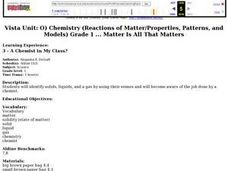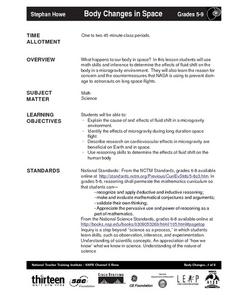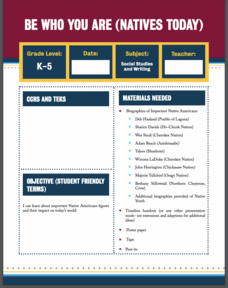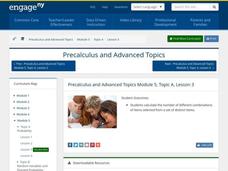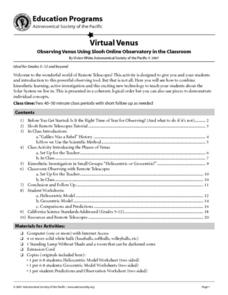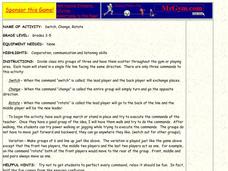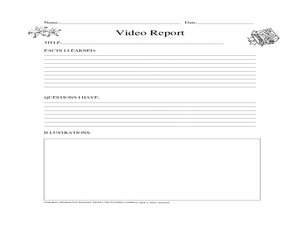Curated OER
I Wonder What Would Happen if Lots of Manduca Lived in a Small Place...
Students discuss the reasons why humans fight and look for similiarties in animals. They make predictions on what they think will happen when they observe insect crowding. They make conclusions about their predictions to end the activity.
Curated OER
Far-out Astronomy in a Suitcase
Ninth graders engage in a web-based research activity. They use a teacher provided worksheet to guide their research through the website. This activity provide a excellent opportunity to showcase Canadians astronomy and space science...
Curated OER
Illustrations in Report Writing
Students create a short report using all the steps in the writing process including a bibliography. They explore different pictures that relate to their topic and download an image for the internet into their report. A helpful rubric is...
Curated OER
Talking About Your Name in Math Terms
Add imagination and creativity to your math lesson plan. Young mathematicians investigate ways to express their names in mathematical terms. For instance, they can count the number of letters, analyze the geometric shapes of the letters,...
Curated OER
A Chemist in My Class?
First graders in kindergarten science class discuss matter. They make predictions and then identify mystery items in brown paper bags as either solid, liquid, or gas by using their senses. They discuss that a chemist is a scientist that...
Curated OER
Patterns in Dance and Math
Students analyze how repeated body movements and shapes can represent and extend patterns. In this pattern analysis lesson plan, students discuss patterns in dance, math, and everyday living. Students demonstrate a dance using a sequence...
Curated OER
Body Changes in Space
Students explain the cause of and effects of fluid shift in a microgravity
environment. Students identify the effects of microgravity during long duration space flight. Students describe research on cardiovascular effects in microgravity...
K20 LEARN
Words Before Blows: Julius Caesar
Scholars examine how Brutus and Mark Antony employ ethos, pathos, and logos in their speeches to persuade the angry crowd in Act 3, scene 2 of William Shakespeare's tragedy, Julius Caesar. To set the stage, groups first identify the...
EngageNY
Counting Rules—The Fundamental Counting Principle and Permutations
Count the benefits of using the resource. The second installment of a 21-part module focuses on the fundamental counting principle to determine the number of outcomes in a sample space. It formalizes concepts of permutations and...
K20 LEARN
The Eyes of Dr. T. J. Eckleburg: The Great Gatsby and the Sense of Sight
To conclude a study of The Great Gatsby, class members create a multimodal project that represents what they feel the eyes of Dr. T.J. Eckleburg see about the hidden side of one of the characters in F. Scott Fitzgerald's classic...
Benjamin Franklin Tercentenary
From Ben’s Pen to Our Lives
What would Ben do? Jumping off from the pseudonymous letters Ben Franklin fooled his older brother into publishing when he was still a teenager, young literary lovers dive into acting, writing, and addressing a local issue with wit and...
Curated OER
Be Who Your Are
An engaging video begins a lesson all about the representation of Native Americans in all types of careers. Following a discussion about the video, scholars participate in a gallery walk showcasing various Native American figures. Pupils...
Frank Macias Elementary School
Preparing for Guided Reading
Take your guided reading lesson plans to the next level with a collection of printables, templates, and reference tools equipped to support the reading needs of your readers. Included is a detailed information page, grouping sheet,...
EngageNY
Counting Rules—Combinations
Discover how combinations are different from permutations. In the third installment of a 21-part module, scholars learn how to determine combinations of objects. They learn to distinguish between situations where order is important and...
Curated OER
Virtual Venus
Young scholars practice using the tool of remote telescopes in order to make observations in space. The lesson includes the best times of year to make observations. They use the internet to obtain information and to initiate the use of...
Curated OER
Elements of Physics: Motion, Force and Gravity
Students research about different human space explorations conducted by NASA. In this physical science lesson, students discuss why space exploration is important. They write a paper about their thoughts on continuing NASA's space...
EngageNY
End of Unit Assessment: On-Demand Informational Paragraph About How the Poison Dart Frog Survives
A final assessment marks the end of a unit that takes a close look at a variety of informational texts all about frogs. A graphic organizer aides scholars in planning an accordion paragraph using their recorder forms from previous...
Curated OER
Water Alchemy
After reading "Aquatic Alchemy," an article about recapturing water for reuse when in space, your class will use calcium hydroxide or hydrated lime to purify cloudy water. Geared toward high school chemistry or environmental science...
Mr Gym
Switch, Change, Rotate
Switch, change, rotate! Players are in groups of three scattered around the playing area. Switch means the lead and back players change positions. Change means the entire group turns and goes in the opposite direction. Rotate means the...
NET Foundation for Television
1850-1874 Homestead Act Signed: Who were the Settlers?
Life in the great, wide-open spaces of the West! Scholars analyze the reasons behind the vast movement to the Great Plains after the passing of the Kansas-Nebraska Act and the Homestead Act. Using photographic, document, map, video, and...
Curated OER
Investigating Planetary Life
High schoolers research about the search for life in Mars. In this space science lesson plan, students develop a creative visual display of their findings. They present their project in class.
Curated OER
Exploration of Mars
High schoolers explore the three-phase strategy used by NASA for scientific exploration. For this space science lesson, students research past missions to Mars. They share their discoveries and create a timeline as a class.
Curated OER
How Hot and How Big?
Students explore star color and size. In this space science instructional activity, students conduct various inquiry activities to explore how the color of a star affects the amount of heat produced. They also investigate how the color...
Curated OER
Twinkle, Twinkle, Little Star
Young scholars identify patterns in the stars. In this constellation lesson, students simulate constellations using black canisters and patterns. Young scholars discuss the points on the constellations and how to draw imaginary lines to...




